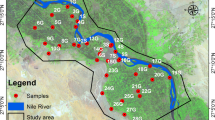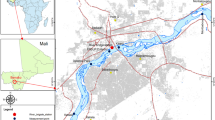Abstract
Concentrations of heavy metals and metalloid in borehole drinking water from 18 communities in Tarkwa, Ghana, were measured to assess the health risk associated with its consumption. Mean concentrations of heavy metals (μg/L) exceeded recommended values in some communities. If we take into consideration the additive effect of heavy metals and metalloid, then oral hazard index (HI) results raise concerns about the noncarcinogenic adverse health effects of drinking groundwater in Huniso. According to the US Environmental Protection Agency’s (USEPA) guidelines, HI values indicating noncarcinogenic health risk for adults and children in Huniso were 0.781 (low risk) and 1.08 (medium risk), respectively. The cancer risk due to cadmium (Cd) exposure in adults and children in the sampled communities was very low. However, the average risk values of arsenic (As) for adults and children through drinking borehole water in the communities indicated medium cancer risk, but high cancer risk in some communities such as Samahu and Mile 7. Based on the USEPA assessment, the average cancer risk values of As for adults (3.65E−05) and children (5.08E−05) indicated three (adults) and five (children) cases of neoplasm in a hundred thousand inhabitants. The results of this study showed that residents in Tarkwa who use and drink water from boreholes could be at serious risk from exposure to these heavy metals and metalloid.


Similar content being viewed by others
References
Akabzaa T., & Darimani A. (2001). Impact of mining sector investment in Ghana: a study of the Tarkwa mining region. Health Impacts, 6(4), 60.
Amasa S. K. (1975). Arsenic pollution at Obuasi goldmine, town and surrounding countryside. Environmental Health Perspectives, 12, 131–135.
Amonoo-Neizer E. H., Nyamah D., & Bakiamoh S. B. (1996). Mercury and arsenic pollution in soil and biological samples around the mining towns of Obuasi, Ghana. Water, Air, and Soil Pollution, 91, 363–373.
Apambire W. B., Boyle D. R., & Michel F. A. (1997). Geochemistry, genesis, and health implications of fluoriferous groundwaters in the upper regions of Ghana. Environmental Geology, 33, 13–24.
Asante, K. A., Agusa, T., Subramanian, A., Ansa–Asare, O. D., Biney, C. A., & Tanabe, S. (2007). Contamination status of arsenic and other trace elements in drinking water and residents from Tarkwa, a historic mining township in Ghana. Chemosphere, 66, 1513–1522.
Bortey-Sam N., Nakayama S. M. M., Ikenaka Y., Akoto O., Yohannes Y. B., Baidoo E., Mizukawa H., & Ishizuka M. (2015). Human health risks from metals and metalloid via consumption of food animals near gold mines in Tarkwa, Ghana: estimation of the daily intakes and target hazard quotients (THQs). Ecotoxicology and Environmental Safety, 111, 160–167.
ECETOC (European Centre for Ecotoxicology of Chemicals) (2001). Aquatic toxicity of mixtures. Technical report, 80. Brussels.
ENHIS (European Environment and Health Information System) (2007). Exposure of children to chemical hazards in food. Fact Sheet No. 4.4, CODE: RPG4_Food_EX1. World Health Organization.
EU (European Community) (1998). The quality of water intended to human consumption. Directive 1998/83/EC, Official Journal L330/05.12.1998. European Community (pp. 32–54).
Ghana Statistical Service (2010). Population and housing census https://www.google.co.uk/#q=Ghana+Statistical+Service%2C+2010.+Population+and+Housing+census+ pp 93.
Giri S., Mahato M. K., Singh G., & Jha V. N. (2012). Risk assessment due to intake of heavy metals through the ingestion of groundwater around two proposed uranium mining areas in Jharkhand, India. Environmental Monitoring and Assessment, 184, 1351–1358.
Hayford E. K., Amin A., Osae E. K., & Kutu J. (2008). Impact of gold mining on soil and some staple foods collected from selected mining communities in and around Tarkwa Prestea area. West Africa Journal of Applied Ecology, 14, 1–12.
Kacmaz H., & Nakoman M. E. (2010). Shallow groundwater and cultivated soil suitability assessments with respect to heavy metal content in the Koprubasi U mineralization area (Manisa, Turkey). Bulletin of Environmental Contamination and Toxicology, 85, 37–41.
Kramer M. L., Kratzin H. D., Schmidt B., Romer A., Liemann O. W., Hornemann S., & Kretzschmar H. (2001). Prion protein binds copper within the physiological concentration range. Journal of Biological Chemistry, 276, 16711–16719.
Li Y. L., Liu Y. G., Liu J. L., Zeng G. M., & Li X. (2008). Effects of EDTA on lead uptake by Typha orientalis Presl: a new lead-accumulating species in southern China. Bulletin of Environmental Contamination and Toxicology, 81, 36–41.
Lim H. S., Lee J. S., Chon H. T., & Sager M. (2008). Heavy metal contamination and health risk assessment in the vicinity of the abandoned Songcheon Au–Ag mine in Korea. Journal of Geochemical Exploration, 96, 223–230.
Liu J. L., Li Y. L., Zhang B., Cao J. L., Cao Z. G., & Domagalski J. (2009). Ecological risk of heavy metals in sediments of the Luan River source water. Ecotoxicology, 18, 748–758.
Mead M. N. (2005). Arsenic: a global poison. Environmental Health Perspectives, 113, 379–386.
Montuori P., Lama P., Aurino S., Naviglio D., & Triassi M. (2013). Metals loads into the Mediterranean sea: estimate of Sarno River inputs and ecological risk. Ecotoxicology, 22, 295–307.
Neves O., & Matias M. J. (2008). Assessment of groundwater quality and contamination problems ascribed to an abandoned uranium mine (Cunha Baixa region, Central Portugal). Environmental Geology, 53, 1799–1810.
Obiri S. (2007). Determination of heavy metals in water from boreholes in Dumasi in the Wassa West District of the Western Region of the Republic of Ghana. Environmental Monitoring and Assessment, 130, 455–463.
PCD (Pollution Control Department) (2000). Groundwater standards for drinking proposes. Manual inspection of contaminated groundwater standards for drinking proposes. Manual inspection of contaminated groundwater from waste disposal facilities. Ministry of Natural Resources and Environment.
PCD (Pollution Control Department) (2004). Drinking water standards http://www.pcd.go.th/info_serv/en_reg_std_water01.html#s1. Ministry of Natural Resources and Environment.
Peplow D., & Edmonds R. (2004). Health risks associated with contamination of groundwater by abandoned mines near Twisp in Okanogan County, Washington, USA. Environmental Geochemistry and Health, 26, 69–79.
Pokkamthanam A. S., Riederer A. M., & Anchala R. (2011). Risk assessment of ingestion of arsenic-contaminated water among adults in Bandlaguda, India. Blacksmith Institute Journal of Health Pollution, 1, 8–15.
Rapant S., & Krcmova K. (2007). Health risk assessment maps for arsenic groundwater content: application of national geochemical databases. Environmental Geochemistry and Health, 29, 131–141.
Roychowdhury T., Tokunaga H., & Ando M. (2003). Survey of arsenic and heavy metals in food composites and drinking water and estimation of dietary intake by the villagers from an arsenic-affected area of West Bengal, India. Science of the Total Environment, 308, 15–35.
Saipan P., & Ruangwises S. (2009). Health risk assessment of inorganic arsenic intake of Ronphibun residents via duplicate diet study. Journal of the Medical Association of Thailand, 92(6), 849–856.
Smedley P. L. (1996). Arsenic in rural groundwater in Ghana. Journal of African Earth Sciences, 22, 459–470.
Smedley P. L., & Kinniburgh D. G. (2002). A review of the source, behavior and distribution of arsenic in natural waters. Applied Geochemistry, 17, 517–568.
Smedley P. L., Edmunds W. M., & Pelig-Ba K. B. (1996). Mobility of arsenic in groundwater in the Obuasi gold-mining area of Ghana: some implications for human health. Environmental Geochemistry and Health, 113, 163–181.
Steinemann A. (2000). Rethinking human health impact assessment. Environmental Impact Assessment Review, 20, 627–645.
USEPA (US Environmental Protection Agency) (1980). Water quality criteria documents; availability. 45. Federal Register, 45(231), 79318–79379.
USEPA (US Environmental Protection Agency) (1992). Definitions and general principles for exposure assessment. Guidelines for exposure assessment. Washington, D.C.: Office of Pesticide Programs, USA.
USEPA (US Environmental Protection Agency) (1997). Exposure factors handbook (EPA/600/P-95/002Fa) (update to Exposure factors handbook (EPA/600/8–89/043), Environmental Protection Agency Region I. Washington, D.C..
USEPA (US Environmental Protection Agency) (1999). A risk assessment–multiway exposure spreadsheet calculation tool. United States Environmental Protection Agency. Washington, D.C..
USEPA (US Environmental Protection Agency) (2001). Baseline human health risk assessment, Vasquez Boulevard and I–70 superfund site, Denver CO http://www.epa.gov/region8/superfund/sites/VB-170-Risk.pdf.
USEPA (US Environmental Protection Agency) (2009). National primary/secondary and drinking water regulations. Washington, D.C.
USEPA (US Environmental Protection Agency) (2012). Ground water and drinking water http://www.water.epa.gov/drink/index.cfm.
Volety A. K. (2008). Effects of salinity, heavy metals and pesticides on health and physiology of oysters in the Caloosahatchee Estuary, Florida. Ecotoxicology, 17, 579–590.
Wayne R. O. (1990). A physical explanation of the lognormality of pollutant concentrations. Journal of the Air and Management Association, 40, 1378–1383.
Wcislo E., Ioven D., Kucharski R., & Szdzuj J. (2002). Human health risk assessment case study: an abandoned metal smelter site in Poland. Chemosphere, 47, 507–515.
WHO (World Health Organization) (2001). Environmental health criteria 224: arsenic and arsenic compounds (Second ed., ). Geneva: World Health Organization.
WHO (World Health Organization) (2011). Guidelines for drinking-water quality (4th ed., http://www.whqlibdoc.who.int/publications/2011/9789241548151_eng.pdf). Geneva.
Wongsasuluk P., Chotpantarat S., Siriwong W., & Robson M. (2014). Heavy metal contamination and human health risk assessment in drinking water from shallow ground water wells in an agricultural area in Ubon Ratchathani province, Thailand. Environmental Geochemistry and Health, 36, 169–182.
Zhang G. S., Liu D. Y., Wu H. F., Chen L. F., & Han Q. X. (2012). Heavy metal contamination in the marine organisms in Yantai coast, northern Yellow Sea of China. Ecotoxicology, 21, 1726–1733.
Zhang N. N., Zang S. Y., & Sun Q. Z. (2014). Health risk assessment of heavy metals in the water environment of Zhalong Wetland, China. Ecotoxicology, 23, 518–526.
Acknowledgments
This study was supported by a Grant-in-Aid for Scientific Research from the Ministry of Education, Culture, Sports, Science, and Technology of Japan awarded to M. Ishizuka and Y. Ikenaka and the foundation of JSPS Core to Core Program (AA Science Platforms). We would like to acknowledge the financial support by the Mitsui & Co., Ltd. Environment Fund, the Akiyama Life Science Foundation, and the Nihon Seimei Foundation. We also express our sincere gratitude and thanks to Mr. Joseph Prah and Mr. Joseph Addae who in various ways assisted to carry out this research. We would like to thank Mr. Takahiro Ichise for helping with the maintenance of the instrument.
Conflict of interest
The authors declare that they have no competing interests.
Author information
Authors and Affiliations
Corresponding author
Additional information
Nesta Bortey-Sam and Shouta M. M. Nakayama contributed equally to this study.
Rights and permissions
About this article
Cite this article
Bortey-Sam, N., Nakayama, S.M.M., Ikenaka, Y. et al. Health risk assessment of heavy metals and metalloid in drinking water from communities near gold mines in Tarkwa, Ghana. Environ Monit Assess 187, 397 (2015). https://doi.org/10.1007/s10661-015-4630-3
Received:
Accepted:
Published:
DOI: https://doi.org/10.1007/s10661-015-4630-3




